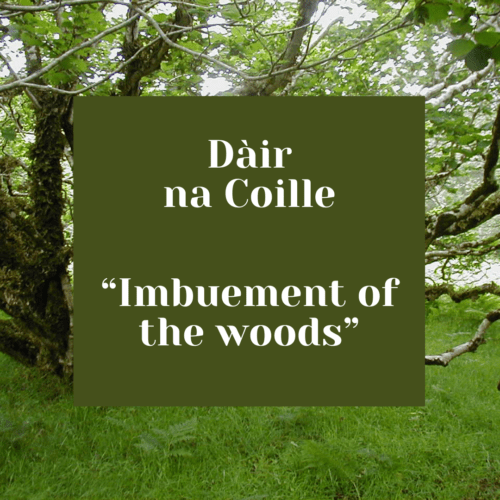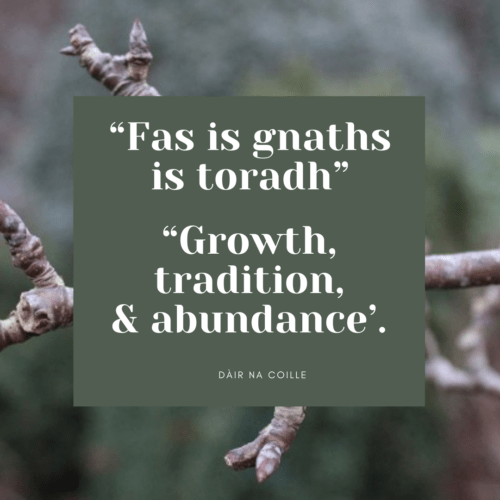Dàir na Coile is a fascinating tradition one we have very little written about. Dàir na coille I have come to love though. Its a counterpoint to consumerism – an invitation to pause and links back into the cyclical idea nature and our dead returning on the wind and brining in new life for spring
We are in the deep of the dark months of the little sun, of long shadows, storms and misty valleys. Moving into darker times comes with so much hype and pressure today but it wasn’t always like this. This year with endless war coverage and worse and worse news for our climate, communities and environment we need a counterpoint more than ever.
Some hope in the dark both literal and metaphorical.
Winter once a slow unfolding now swallowed by razzle-dazzle demons of capitalism, consumerism and materialism. These neon demons scream from our phones screens, social media accounts, TV and shop windows their own awful litany. Their glossy shallow grimaces embodied in the patronising smiles of a thousand hallmark cards and Christmas specials.
Winter is darkness and incubation.
Personally, I think we should use this sacred special inward time of grace and liminality to welcome the other crowd and rest. Winter, for me, is a time to coorie doon with warm soup, comfortable clothes, smelly cheese (side note – we seek this during winter because of its vitamin D content amongst other things – its a Scottish ancestral food), dare I say also contentment and grace? Sadly we have been sold the story of idleness. To rest is to be lazy. “Idle hands are the devils playground”.
What should be a collective rest period has become a flurry of shopping and buying and socialising and then posting to social media providing even more shine and pressure.
Our collective “laziness” will be slandered come the first of January.
The neon demon screaming full pelt into the cycle of shame in your laziness, shame in your idleness and shame in all that delicious cheese eating.
There is no sin in idleness. Rest is a gift.
Winter is contemplation time, peak story telling season and remembering – there’s a reason the Yules are peak ghost story season and filled to the brim with tales of our collective dead – the wild hunt rides through the storms literally rattling our windows and swelling our rivers. The slaugh na marbh (host of the dead) out with them- In the words of British folklorist Lewis Spence:
“In the Western Isles of Scotland the Sluagh, or fairy host, was regarded as composed of the souls of the dead flying through the air, … Usually taking a crescent form, similar to a flight of grey birds, they were said to be able to approach and pick up a person from any direction and then transport them far away through the air, from one island to another. Although they would sometimes rescue humans from dangerous rock clefts, they were generally portrayed as dangerous to mortals.”
Why then come January do we feel such shame in our idleness we think its good idea to go out jogging in all that?

Dàir na Coille – The counterpoint
Dàir na Coille speaks to these hoards of the dead – blowing through the leafless slumbering trees and renewal and rest.
I first came across the concept of Dàir na Coille in the Gaelic dictionary of plants:
“New Year’s time is called in Gaelic, ‘oidhche collie” the first night of January, then the hazel is in bloom. The first night in the new year, when the wind blows from the west, they call dàir na collie, the night of the fecundation of trees (“Statistics,” par. Kirkmichael).” Dwelly’s dictionary confirms this.
I then heard more information from one of our guest lecturers at the Winters last event. You can hear more about this in the film.
Dair na Coille, (pronounced dayr na col-ya) the ‘imbuement of the woods’ or the ‘impregnation of the woods’, is part of Scottish Gaelic folk custom. Dáir na Coille takes place on hogmanay or the last day of December in preparation for the New Year.
Further information is found in McKay, J (1928) “New Year as candlemas in Scotland”:
“dàir na coille – the rutting of the wood applied according to Armstrong to the first night of the new year when the wind blows from the west. also associated with the “tarbh-coill” a dark cloud which is seen on New Years eve portended dark and stormy season. We might compare this with the idea of the idea of the three realms and portends of such were important.”
Brian Walsh interprets this beautifully and refer to him now
“Dàir na Coille celebrates the arrival of blessings, life-forces, and spirits, brought on the West Wind and nestled in the trees until each new blessing and new life, and new spirit emerges in due course in the months ahead. On New Year’s Day, the head of the household would go out and get a small twig from a fruit-bearing tree and bring it into the house saying “Fas is gnaths is toradh”, meaning ‘Growth, tradition, and abundance’, so that his family could share in the blessing of the new emerging life. As far as I know, this is all that remains of this custom. We are not told where the blessings and spirits come from exactly, or who sends them, however, we can interpret the symbolism that is still present in this simple custom.
The new spirits are brought in on the West Wind, which, apart from being wonderfully animistic, says something important. The wind is a vehicle for vitality; we affirm this fact with every breath we take, but the West, the direction of sunset, death, and the ancestors, is a direction of endings. So these newly arriving spirits come from the place unto which departing spirits go. The spirits are not just coming, the spirits are returning! Renewed!
Michael Newton suggests in his handbook of the Scottish Gaelic World that the individual trees imbued in Dair na Coille are a source of life, much as the Tree of Life is the ultimate source of life.”
I think the portent of the stormy cloud ties in nicely to Brians beautiful interpretation of this tradition. The clouds in the sky were also sometimes referred to as flocks of birds according to McKay and there is a lot of lore linking souls of the dead to birds and visitations from bullfinches and the wren at this time of year attest to that.
The significance of the tree branch brought in is so beautifully poignant – a fruiting wood in winter during a time of death and bleakness.
Midwinter a time of the dead in our lore, they are blowing through the trees like birds, as wild hunt rides the storms – here held in the west wind – and in some traditions the dead would always travel to the west to the house of Donn or be scooped up by the hunt if they have been earth bound for the year. a cleaning of the old making way for the new. On this one night the dead become bringers of fecundity to nature.

“Fas is gnaths is toradh”, ‘Growth, tradition, and abundance’.
“Toradh” is not only abundance but the sustenance our otherworld visitors take from the offerings we give at this and other times of the year – its the reason we put iron objects in butter when folks die or at the wakes least their spirit take the “toradh” of the food.
The production of the twig or branch with these words is suggestive of bringing the blessing of the bile tree or an indication of the world tree tradition in our melting pot of a society but this is solely conjecture. That being said there are many many allusions to family and trees in Gaelic and Scottish phrases – so its not too much of a stretch – it also suggests the stories of the birth of the human race from trees in some stories. Its just beautiful however you might want to dissect it in your own way.
So perhaps in Dàir na coille we have an antidote – a moment of calm – a collective shot in the arm, a way to exorcise these neon demons of materialism and its heavy consumerism and bring us back to focus on what is really the reason for the season.
“Fas is gnaths is toradh”, ‘Growth, tradition, and abundance’ to you all. here’s hoping it can helps us find our way back to dòigh nàdair the way of nature.



3 comments
Refreshing, thank you 🎄
Fascinating,many thanks for the information.
Thanks for the nice feedback :)